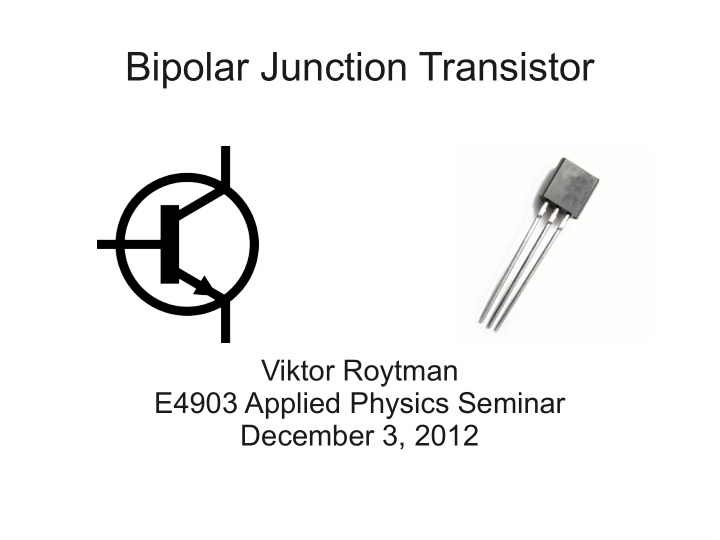



Bipolar Junction Transistor Viktor Roytman E4903 Applied Physics Seminar December 3, 2012
What is a transistor? ● Device used to amplify or switch signals ● Computer processors ● Progress ● Vacuum tubes, early field effect transistors, BJT ● Moore’s Law
Overview ● Inventors (1956 Nobel Prize) ● History ● Physics ● Modes of Operation
Inventors John Bardeen Walter Brattain
Inventors ● John Bardeen and Walter Brattain ● Employees of Bell Laboratories ● Worked under William Shockley (3 rd inventor) ● Did much of the work ● Afterward ● Shockley claimed most of the credit ● Strained relationship ● Bardeen won a 2 nd Nobel Prize for BCS theory of superconductivity (1972)
Point Contact Transistor
Inventors ● William Shockley ● Worked in secret on better transistor design ● Major contributions to semiconductor physics ● Racist ● Public proponent of eugenics
History ● Bell Labs wanted to create a solid state triode ● Faster switching time ● Cheaper ● More reliable ● No need to warm up ● Surface physics ● Charge carrier behavior ● Bardeen established this new subject
Physics ● Simplest picture ● Two p-n diodes joined together ● Flow of electrons and holes depends on doping and bias ● E: Emitter ● B: Base ● C: Collector ● I C = βI B ● β typically ~200
Amplification ● The current in the base is given by Where q is charge, D n is diffusivity of electrons, n pE0 is density of holes, A E is area, W B is width, V BE is the potential across the base-emitter junction, and v th is thermal speed. ● Similarly, current in the emitter is given by ● Also, ● So that Where N represents dopant concentration. For typical values of these parameters, β is around 200 but varies with use because of implicit dependence on temperature and bias.
Modes of Operation ● Forward Active ● Reverse Active Region Region ● BE forward biased, ● BE reverse biased, BC reverse biased BC forward biased ● Saturation ● Cutoff ● Both forward biased ● Both reverse biased ● “On” ● “Off”
References ● “John Bardeen and the Point Contact Transistor.” Physics Today , Apr. 1992. ● “Compound-semiconductor Transistors.” Physics Today , Oct. 1986. ● “The Transistor.” Scientific American , Sept. 1948. ● “The Future of the Transistor.” Scientific American , Jun. 1993. ● 2010 ELEN3106 Lecture Notes ● Hyperphysics – Transistors. <http://hyperphysics.phy- astr.gsu.edu/hbase/solids/trans.htm>
Recommend
More recommend